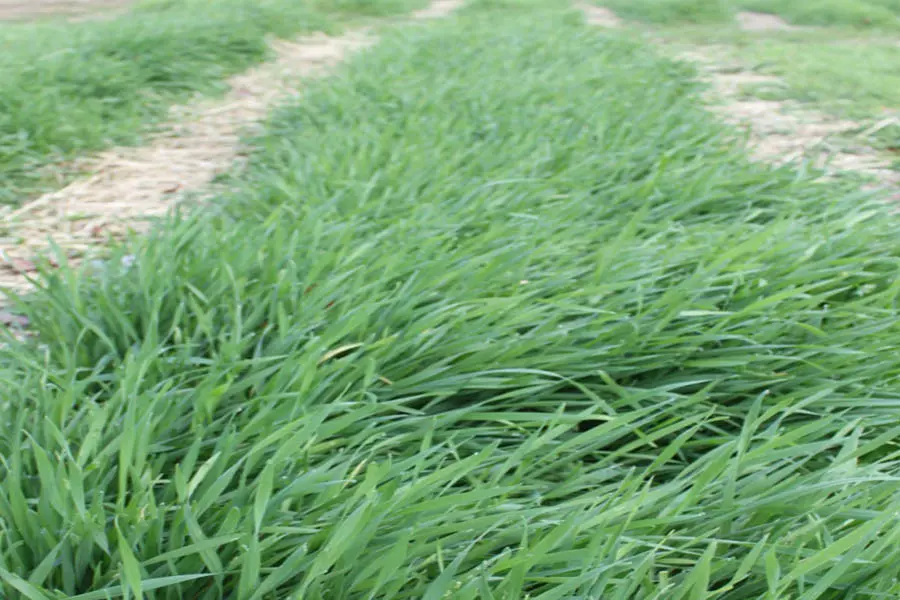
One of our first and favorite experiments – the DIY stake a cage
If you have followed us for any amount of time now, you know that we love to try new things in the garden. And now that we finally live at the farm, we are not about to stop that tradition this year!
A little part of me wonders why we are trying this year’s big experiment. But then again, it makes perfect sense! We’ll get to that in a moment.
Ever since we began gardening, our garden has really been one great big experiment. First with the raised rows, then cover crops. Then planting through cover crops for a completely no-till, no work garden. And of course other trials like the stake-a cages, growing potatoes in crates, and more.

The first few years, we covered our walking rows with straw and leaves
With each new trial, we were simply searching for a way to simplify. To grow our food organically, with less maintenance, less hassle, and more fun.
When we first created our rows in 2011 – we used what we had on hand to cover our walking rows. That was straw and leaves. They worked fairly well in keeping weeds out of our rows, but the straw was a bit pricey, and we wanted to try something that was a bit more permanent and less expensive.
So we trialed bark shavings that were an inexpensive by-product of a nearby sawmill. They have worked unbelievably well. In fact, so well that this is where I say I somewhat wonder why we are trying something new at all.
But even though the wood chip bark has worked great for us, we would get email after email from readers asking for other inexpensive ways. Not everyone has access to cheap wood chips, straw, or leaves. In fact, there are also a lot of people who have trouble finding even compost materials for their compost pile. And then the light bulb went off! What if we used cover crops in the growing rows to keep out weeds – AND provide great compost material all summer long.
Using Cover Crops For Our Walking Rows
Last year, for the entire garden, we actually kept our cover crops in the rows and never turned over the soil. The result? one of our best gardens ever without any work of turning the soil over.

We have used all bark chips for the last few years, and the weeds have been near 0
During that process, we mowed off the strips of the cover crops all spring, using the bagged contents to throw into our compost pile. It was the brightest, greenest, most fertile shredded clippings we could have added, and I am positive it really helped our compost pile do even better.
So…what if we just simply planted some of our walking rows in a cover crop like annual rye. I mean the bark chips work incredibly well. They really do, But they do cost a little bit, and we do have to replace them a bit every few years. Now you get the most low maintenance, organic solution of all!
So this year, we will rake off one-quarter of our bark walking rows and use that to help top off the remainder of walking rows still in bark. Next, we will seed those empty walking rows with a thick seeding of annual rye in the early spring. Annual Rye Seed
The Hopeful Result…
First off, it’s dirt cheap – pardon the pun! And there benefits only get better from there.
As the annual crop grows, we can can use our bagging push mower to mow the walking rows easily. We can then dump those clippings continually into our compost bins all summer long. After all, the middle of summer and late spring, it can be hard to find enough materials. This is the perfect solution.

The thick lush annual rye clippings will be great for the compost pile
The thick, lush covering of annual rye will snuff out any weeds in the rows, and be easy to walk on when it rains. And those bright green walking rows should look more like the fairways of a lush golf course. It’s a cycle that should easily be able to repeated every spring without ever having to till a thing.
I guess we will see if it works. Who knows, maybe in a few years you will see photos of our garden with all green walking rows and no bark mulch. We will be sure to let you know how it works. Who knows, maybe we can make this an even lower cost, lower maintenance garden. And I am sure we will still try to do something new! 🙂 After all, that is the thrill of gardening – you just never know!
Happy Gardening– Jim and Mary! We hope you enjoyed this week’s gardening article! If you would like to receive our DIY, Gardening and Recipe articles each week, you can sign up to follow the blog via email in the right hand column above, “Like” us on Facebook, or follow us on Twitter. This article may contain affiliate links.
